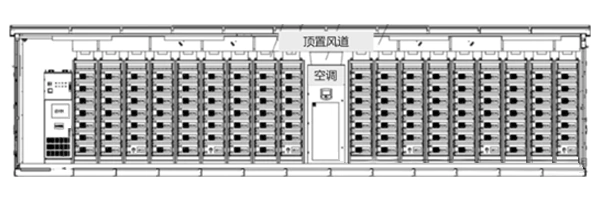エネルギー貯蔵の不一致 電池は主に電池などのパラメータの不一致を指します。 容量、内部抵抗、温度。私たちの日々の経験は、 2つの乾電池をプラスとマイナスの方向に接続すると、 懐中電灯は点灯しますが、私たちは点灯しません 一貫性を考慮します。しかし、電池が大規模に使用されると、 エネルギー貯蔵システムの場合、状況はそれほど単純ではありません。矛盾がある場合 電池を直列および並列で使用すると、次の問題が発生します。
1.利用可能な容量の損失
エネルギー貯蔵システムでは、電池セル (つまり、バッテリーセル)が直列に接続されてバッテリーパックを形成し、 バッテリーパックは直列に接続されてバッテリークラスターを形成します。複数 バッテリークラスターは同じ DC バスに直接並列接続されます。の セルの不一致による利用可能な容量の損失の理由には次のものがあります。 直列不一致と並列不一致。
(1) 電池パックシリーズの紛失 不一致:
差異などの不一致があるため バッテリーセル自体の温度差とバッテリー間の温度差 バッテリーパックごとにSOC(残量)が異なります。として 1 つのバッテリ パックが満杯または空である限り、クラスタ内のすべてのバッテリ パックは 充電と放電を停止します。

図 1. バッテリー 不一致により直列容量の不一致が発生します
(2) 不整合損失 バッテリークラスター並列接続:
バッテリーパックを直接取り付けた後 並列接続してバッテリークラスターを形成し、各バッテリーの電圧 クラスターは強制的にバランスが取られます。バッテリークラスターが小さい場合 内部抵抗が完全に充電または放電されている場合、他のバッテリー クラスターは 充電と放電を停止する必要があり、その結果、バッテリークラスターが充電されなくなります。 完全に充電または完全に放電。

図 2 動作時の電流差 複数のバッテリークラスターの並列放電
また、内部が小さいため、 各クラスター間の電圧差があってもバッテリーの抵抗 不整合によって引き起こされる電流はわずか数ボルトであり、 クラスターは非常に大きくなります。発電所の実測データでわかるように 以下の表では、充電電流の差は 75A に達します (偏差 理論平均値と比較すると42%です)。偏差電流は、 一部のバッテリークラスターで過充電と過放電を引き起こします。それは大いに 充放電効率、バッテリー寿命、さらには原因に影響を与える 重大な安全事故。
|
|
充放電 |
電圧 |
現在 |
SOC |
|
最初のクラスター |
チャージ |
793.2V |
-197.8A |
66 |
|
第二クラスター |
チャージ |
795.3V |
-126.6A |
77 |
|
第三クラスター |
チャージ |
792.8V |
-201.6A |
66 |
表1 測定データ 発電所
2.エネルギーの寿命が短くなる ストレージシステム
温度は最も重要な要素です エネルギー貯蔵の寿命に影響を与えます。内部温度が上昇すると、 エネルギー貯蔵システムの寿命は 15 °C 上昇します エネルギー貯蔵量は半分以下に短縮される。 リチウムイオン バッテリーは、充電および放電のプロセス中に多量の熱を発生します。 単セルの内部抵抗が一貫していないため、 エネルギー貯蔵システム内の温度分布が不均一になり、 バッテリーの劣化と減衰率が増加し、最終的にはバッテリーの寿命が長くなります。 エネルギー貯蔵システムは短縮されるだろう。
温度が上昇していることがわかります。 エネルギー貯蔵システム内のバッテリーの不一致は重要な問題です。 エネルギー貯蔵システムの性能に影響を与える要因。減りますよ エネルギー貯蔵システムの利用可能な容量が減少し、サイクル寿命が短くなります。 エネルギー貯蔵システムを破壊し、さらには安全上の危険を引き起こす可能性があります。
対処方法 エネルギー貯蔵電池の不整合?
バッテリーセルのばらつきは、 製造過程で形成され、使用中に深くなります。弱ければ弱いほど、 同じバッテリーパック内のバッテリーセルは弱くなり、より弱くなります。 彼らです。ただし、完全に一貫したバッテリーセルはありませんが、 デジタル技術、パワーエレクトロニクス技術の融合が可能 蓄電技術とパワーエレクトロニクスの制御性を活用 リチウム電池の不一致による影響を最小限に抑える技術。それに応えて 前回の記事で分析した不整合によって引き起こされる問題に対して、 市場の一部のメーカーはストリングエネルギー貯蔵システムを発売しています。 洗練されたエネルギー管理と分散型の特徴を備えた 温度管理に使用でき、症状の治療に使用できます:
(1) 洗練された経営 利用可能な容量を増やす
従来のPCSと比較すると、 1,000 ~ 2,000 を超えるセルを管理するストリング エネルギー貯蔵システム セル管理の精度が約 100 倍から 10 倍以上に向上します。 倍高い。バッテリーパック間のシリーズ不一致を考慮して、 オプティマイザーは、充電と放電を個別に管理できるように設計されています。 各バッテリーパック。バッテリーパックが設定されたしきい値に達すると、バッテリー パックはバイパスされ、他のバッテリー パックは充電と放電を続行できます。 相互に影響を与えることなく、バッテリー容量を最大限に活用します。
同時に、各バッテリークラスターは バッテリーの影響を回避するインテリジェントクラスターコントローラーを搭載 直接並列接続すると不整合が発生するため、充電と 各クラスターの放電電流は、誤差 1 で正確に制御できます。 1%未満です。これにより、クラスタ間の不一致が回避され、真の実現が可能になります。 バッテリークラスター間の独立した充放電管理、 循環の発生をなくし、能力と能力をさらに向上させます。 システムの安全性。
(2) 分布温度 エネルギー貯蔵システムの寿命を延ばすための制御
従来のエネルギー貯蔵コンテナは 集中空調機を1~2台設置し、縦通風ダクトを採用 放熱用。エアダクトの長さは約6メートルから12メートルです。 メートル。長い熱放散チャネルにより、温度の一貫性が確保されます。 各バッテリーパックおよびバッテリークラスターの保証はできません。

図 3 従来の 集中放熱構造
ストリングエネルギーストレージはクラスターレベルを使用します 分散型熱放散、代わりに分散型空調を使用 集中空調。各バッテリークラスターは熱を放散できます 独立して均等に、エアダクトの長さは1メートル未満です。 放熱効率が大幅に向上し、温度上昇を防ぎます。 物理的な場所によって生じる違い。同時にバッテリーパックも 木の形をしたバイオニック特許取得済みの放熱ダクトを巧みに使用して調整します。 各バッテリーセルのダクトの長さと距離により、冷却量が 各バッテリーセルを通過する電流は可能な限り一貫しており、 各バッテリーセルの各表面の温度の不一致。

図 4 分散 放熱構造図
バッテリーの不安定が根本的な原因です 現在のエネルギー貯蔵システムには多くの問題があります。ただし、化学物質のせいで、 電池の特性や使用環境の影響、 バッテリーのばらつきを解消するのは困難です。ストリングのエネルギー貯蔵 システムはバッテリーの一貫性に対するシステムの要件を大幅に弱めます パワーエレクトロニクスとデジタル技術の制御性により、 エネルギー貯蔵システムの利用可能な容量を大幅に増やすことができ、 システムの安全性を向上させます。